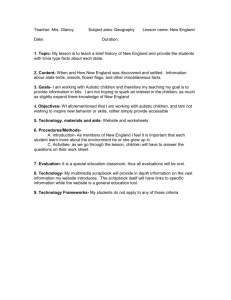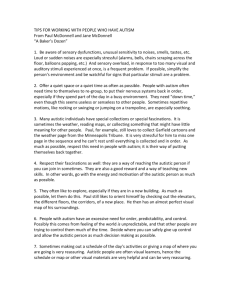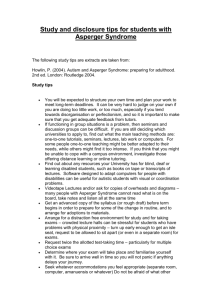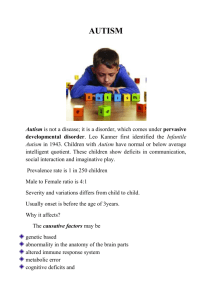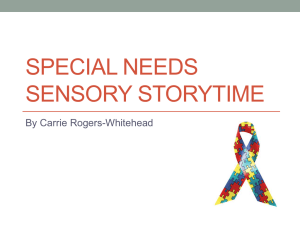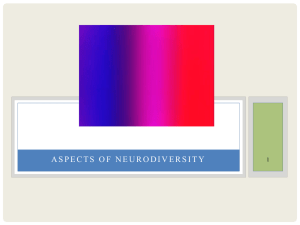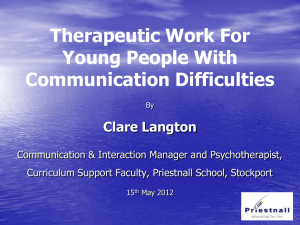Annotated Bibliography
advertisement
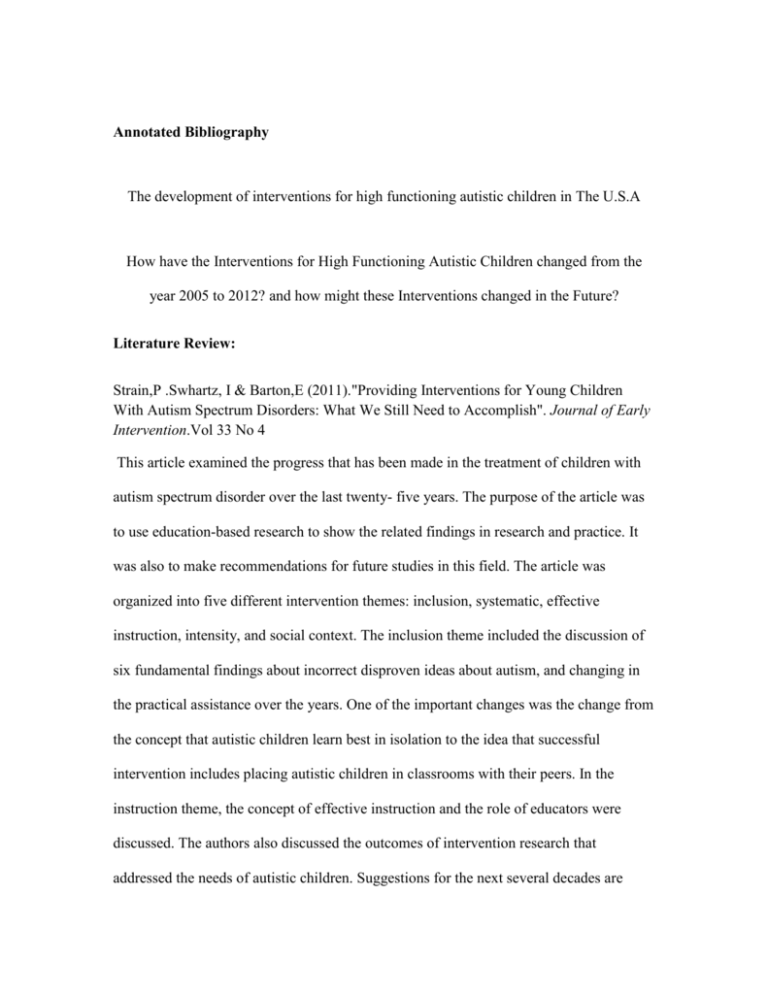
Annotated Bibliography The development of interventions for high functioning autistic children in The U.S.A How have the Interventions for High Functioning Autistic Children changed from the year 2005 to 2012? and how might these Interventions changed in the Future? Literature Review: Strain,P .Swhartz, I & Barton,E (2011)."Providing Interventions for Young Children With Autism Spectrum Disorders: What We Still Need to Accomplish". Journal of Early Intervention.Vol 33 No 4 This article examined the progress that has been made in the treatment of children with autism spectrum disorder over the last twenty- five years. The purpose of the article was to use education-based research to show the related findings in research and practice. It was also to make recommendations for future studies in this field. The article was organized into five different intervention themes: inclusion, systematic, effective instruction, intensity, and social context. The inclusion theme included the discussion of six fundamental findings about incorrect disproven ideas about autism, and changing in the practical assistance over the years. One of the important changes was the change from the concept that autistic children learn best in isolation to the idea that successful intervention includes placing autistic children in classrooms with their peers. In the instruction theme, the concept of effective instruction and the role of educators were discussed. The authors also discussed the outcomes of intervention research that addressed the needs of autistic children. Suggestions for the next several decades are mentioned as well. In addition, the needed improvement in different areas of autism included more treatments, easier and more available access to public services, and further research. Finally, what is needed for the next twenty - five years is more understanding and supporting for change. Since there are many autistic children who do not respond to interventions, researchers can create new types of interventions and methodologies that can help autistic children success and over come many obstacles, such as, educational and social obstacles. These new methods can help more non-responding autistic children learn to interact and communicate with others. Indeed, knowledge is always changing, and improving in this field, and researchers some times have different point of views about interventions. For instance, the results of Strain et al (2011) and Denning (2007) in their studies were different than Laushey et al. (2009). Strain et al (2011) and Denning (2007) found that social skills groups have become a popular as well as useful way to teach social skills. Many schools use peer tutoring and peer coaching to teach children with autism spectrum disorder. In contrast, Laushey et al. (2009) warns that the interventions that only use peers to teach social skills are not enough. Their study included both peer groups and social skill training. The results of their studies were that the combination of peer groups and adult instruction helped students learned the social skills that were taught. Schaefer, P.Travers, J & Harnik, J. (2009). Academic Achievement and Strategy Instruction to Support the Learning of Children with High functioning Autism. Journal of Beyond Behavior. University of New Nevada, Las Vegas. This article discussed some common academic problems and deficits that high functioning autistic children and children with Asperger syndrome experience. Students with these disorders need more tailored instruction in schools. They have difficulty with the three core subjects of reading, writing, and mathematics, which affect their educational progress. In each of these subjects, the students have deficits that affect their overall achievement. Many of the deficits are related to attention difficulties. This article included many literature reviews to discuss academic subjects such as, reading, writing, and mathematics. Moreover, it also discussed developments in the needs, instructional strategies, and interventions for HFA. Children with this disorder have basic reading, writing and mathematics skills, but they have difficulty with problem solving, organization, and self-correction. It is importance to understand the academic profile of students because understanding and gathering academic information is a useful way to create suitable interventions. In addition, any intervention for high function autistic children and children with Asperger syndrome should include assessments, identifying needs, explicit instruction and evaluation. Interventions should include cognitive and meta-cognitive strategies to help the children learn to identify their errors. Also, educators apply these strategies to correct students’ errors. However, the details of the strengths and weaknesses of each child are different. The authors explained that understanding the academic profile for students is important, but not efficient enough to cover all their individual needs. Instructors should conduct direct observations and analyze the errors of each child because what works for a group may not work for every student. Like Luscer (2009), Schaefer et al (2009) also addressed the importance of evaluation students academic needs to determine the appropriate and useful intervention that help them. In addition, Scheeren & et al. (2012) and Schaefer & et al. (2009) stated the importance of observation method to assess problem areas , and to collect the needed data for high functioning autistic children in order to help them overcome such educational and social obstacles. Furthermore, Scheeren (2009), focused on observing high functioning autistic children in several aspects, such as, communication, performance in social activities, and interesting activities, while Schafer et al (2009) focused on educational curriculums observation. For instance, Schafer et al (2009) focused on students’ performance in classrooms and academic achievement. Moreover, there is also agreement between Schaefer &et al. (2009) and Strain& et al (2009) about strategy instructions. They followed strategy instruction to teach high functioning autistic children a variety of social skills, such as, solve problems, and act independently. Methodologies: Scheeren. A, Koot H. & Begeer B. (2012). Social Interaction style of Children and Adolescents With High- Functioning Autism Spectrum Disorder. Journal of Autism and Developmental Disorders. DOI 10.1007/s10803-012-1451 The article investigated whether different social interaction styles are related to different degrees of autism. The authors examined 214 autistic people (183 boys; 31 girls) to discover the main causes of the differences in social interaction styles in autistic children. The social interaction styles of the Autism Spectrum Disorder (ASD) were divided into three categories, the unresponsive unsocial ‘aloof’ children, the socially passive children, and the active but odd children. Assessments, and observations were used to evaluate emotion regulation, cognitive, behavior, orderliness, planning, and initiative behavior. The Autism Diagnostic Observation Schedule-Generic (ADOS-G), Social Responsiveness Scale (SRS), Disruptive Behavior Disorders Rating Scale (DBD), Interpersonal Reactivity Index (IRI) and Behavior Rating Inventory of Executive Function (BRIEF) assessments were used to measure disruptive behavior, severity of problems, and the social interaction styles of the children. The results include that there was a small relationship between the odd style children and the autism spectrum disorder. The odd children were measured as more intelligent with less severe symptoms than the children with other two social interaction styles. In addition, the passive and aloof children were weak in the areas of social motivation and initiative. Therefore, it was recommended that interventions focused on social motivation would benefit these children. However, this form of intervention would not have an effect on the odd children. The researchers suggested that interventions should focus on the strengths and weaknesses of the autistic children. Different social interaction styles should be related to the needs of the children when choosing interventions. The researchers’ purpose was to find out if the differences in social interaction styles were related to the severity of autistic symptoms, the psychosocial health, or the significant functioning and skills of the children. They try to clarify the social interaction distinctions between children along the high functioning autism spectrum disorder (HFASD) and children with autism spectrum disorder ASD. Researchers have shown that children with HFASD have higher intelligence and they are more likely to start and react with social interaction. In addition, research has shown that intelligence could be the vital role that allows high functioning autistic children to succeed in their educational and social lives. Most of the high functioning autistic children were characterized by intelligence and showed active roles in initiating and responding to social interaction. There are similarities between the findings of Scheeren et al(2006) and Laushey et al.(2009) about evaluating the needs of people with special needs. Scheeren et al. (2006) suggested that both the strengths and weaknesses should be studied before choosing an intervention method. Thus, interventions should be mostly based on evaluations of the needs of each individual child. In addition, they found that a variety of settings, methods, and information about the child are helpful in choosing an appropriate intervention method. Likewise, Laushey et al. (2009) stated that there is a wide range of abilities that affect behavior and learning. Therefore, educators should learn about the strengths of high functioning autistic children. This is mainly because it is particularly important when educators seek to find the best ways to teach skills. Their study found that focusing on particular skills, and reinforcing them was effective. Laushey , K. Heflin ,J. Shippen, M. Alberto, P. & Laura, F.(2009). Concept Mastery Routines to Teach Social Skills to Elementary Children with High Functioning Autism. Journal of Autism and Development Disorder (2009) 39:1435–1448 I 10.1007/s10803009-0757-9 This article is a quantitative study that examined how educators follow the Concept Mastery Routine (CMR) to teach high functioning autistic children social skills. Some researchers have supported the idea that setting autistic children in general classrooms with their peers is sufficient enough for needed social skills to be learned. However, this article argued it is not enough to only use social modeling to support such social skills, but using and reading visual cues is also needed. The article suggested that the solution is to combine peer and adult intervention practices. Placing high functioning autistic children in general classrooms and supplementing with CMR intervention outside of the class in controlled social groups could increase the learning of social skills. Three goals were presented for two reasons: to increase focused social skills and to encourage skills maintenance. Researchers applied this intervention to four high functioning autistic boys in first and fourth grades in two different schools. The results indicated that the three boys showed significant improving in their social skills. For instance, before applying CMR intervention, three of the four boys said they did not have a "best friend." However, after applying this method, all four boys had a best friend. Moreover, because this intervention depended on visual processing, the boys made positive advances in this area. In all, the article’s findings seemed to support that social skills can be increased if both adult and peer intervention is used. Concept Mastery Routine (CMR) intervention plays a major and fundamental role in enhancing the social skills of high functioning autistic children. This is because it helps educators understand what works and what does not work. For instance, after this intervention, educators discovered that using visual aids is effective and necessary. One of the implications for the future research was to find other intervention methods that will also be effective in teaching visual skills. It is obvious from the introduction and discussion sections of this article that methodologies have changed from using one intervention method at a time to combining more than one teaching methods. This study uses direct teacher instruction and help from peers to teach social skills. The recommendation from this study is that both teacher instruction and social skills groups should be part of the concept mastery routine to teach high functioning autistic children. Similarly, In Denning’s (2007) literature review, he stated that social skills groups are very common, but the results are based on what educators say are successful. Educators should be aware of this and be careful about how important they make social groups in interventions. Huang. A, Wheeler. J (2006). Effective Interventions for Individuals with High Functioning Autism. International Journal of Special Education. Vol. 21 No.3 This article included numerous interventions for high functioning autistic children (HFA) that had positive effects on them. The first intervention included structured teaching approaches, which helped the children be interested in the classroom activities. The second kind of intervention was routines and schedules. These interventions help HFA students adjust to the classroom atmosphere. Consequently, they will feel less stressed, and they will reduce behavior problems overtime. The third intervention was adapted structured strategies. It included three main strategies: set instructional language, adjust written information, and students’ special interest, which was used to enhance educational skills. The fourth intervention was the modification of learning environments. High functioning autistic children learn better when in organized and controlled environments. The fifth type of intervention was peer-mediated, and it showed positive results when educators applied it to five students with autism. Another type of intervention was self-monitoring, and it included several advantages that showed improvements in vocalizations in autistic children. Video modeling was another kind of intervention that showed positive results in the areas of communication, proper behavior, and academic achieving. This intervention also showed positive effects not only on high functioning autistic children, but also on children with different disabilities. The last kind of intervention was the social stories. Research showed that social stories were an effective method to help HFA children increase their proper behaviors and decrease their inappropriate behaviors. HFA children were enhancing their social skills when following the social stories intervention. Finally, the authors demonstrated several steps on how to create successful social stories. The finding of this study is comparable to Denning’s (2007) findings. They found that the use of social stories intervention is effective in teaching social skills to high functioning autistic children. In addition, they found that peer mediated intervention or tutoring intervention are important in decrease behavior problems and in increase social interaction for high functioning autistic children. Their methods were to show the autistic children good and bad behaviors. While Hung & Wheeler (2006), and Parsons et al (2010) focus on the positive results from using peer coaching or tutoring interventions in teaching high functioning autistic children the desired skills, Denning (2007) highlight two limitations from using peer tutoring intervention. The first one was the lack of quality interventions as more statistical research is required for support. The second limitation was that the interventions should be constantly applied to students and not just limited to their free time from classes. Landa, J & Goldberg, M. (2005). Language, Social, and Executive Functions in High Functioning Autism: A Continuum of Performance. Journal of Autism and Development Disorder.Vol. 35, No. 5 This study investigated the language, social and executive abilities of children with high functioning autism (HFA). The goal was to find the connection between them. Nineteen children between the ages of 7 and 17 were included. In addition, there was a control group with the same ages and IQs. Before the children participated in the study, the Autism Diagnostic Observation Schedule – Generic (ADOS_G) was used to interview people who care for the autistic children. Moreover, the children were given the Wechsler Intelligent Scale (WISC-III). The results indicated that all of the high functioning autistic children scored above 80. During the testing, all of the children were individually evaluated three times for a total of eight hours. They were tested in three parts: grammar, memory and flexibility .The findings were that the group of high functioning autistic children scored lower than the control group on the social and language tests. The high functioning autistic children had more difficulty with making sentences, language comprehension, memory tasks, and planning. In addition, the high functioning autistic children had more difficulty with identifying figurative language. However, some of the HFA children scored better than the control group on the flexibility tasks. Furthermore, the authors claimed that there was a relationship between the children’s IQ and their language abilities. However, they did not find a relationship between their social abilities and planning abilities. They concluded that autistic children have significant social and language deficits but they could not find that their executive abilities were a problem. Landa & Goldberg’s (2005) study confirm what Scheeren et al. found in their 2012 research. They found that high functioning autistic children have social and executive deficits. Both of them follow different type of intervention that showed high functioning autistic children exhibit social and executive deficits. For instance, Scheeren et al. (2012) followed the Behavior Rating of Executive Function (BRIEF) to measure several aspects in autistic children, such as, disruptive behavior, severity of problems, and social interaction styles. Landa & Goldberg (2005) followed the Autism Diagnostic Observation Schedule – Generic (ADOS_G) to interview people who care for the autistic children. The results indicated that high functioning autistic children showed a high percentage of executive operative problems correctly in their daily lives. In addition, Landa & Goldberg (2005), Scheeren et al. (2012) and Schaefer et al. (2009) believe that observation methods are valuable in measuring success. Furthermore, there is similarity between the findings of Landa & Goldberg (2005), and Schaefer (2007). Both indicated that high functioning autistic children have deficits in language. These deficits included reading, and writing. Furthermore, these deficits affected their overall achievement. Janine ,S. Visovsky, H. Randolph ,S & Schultz T. (2010) Social Competence Intervention for Youth with Asperger Syndrome and High-functioning Autism: An Initial Investigation. Journal of Autism and Development Disorder ,40:1067–1079 DOI 10.1007/s10803-010-0959-1 People with high functioning autism (HFA) or Asperger syndrome (AS) exhibit difficulties with social interaction. These difficulties appear in three parts of social cognition, which are: theory of mind, emotion recognition, and executive functioning. Educators applied the Social Competence Intervention (SCI) to 27 students who had high functioning autism and Asperger syndrome. There age ranged from 11 to 14 years old. The students met in groups of 6 students after school. This intervention was designed to help these students with high functioning autism and Asperger disorder meet their social needs as well as improve the different challenges that they face in their lives. In addition, this intervention was designed to motivate and encourage the students to adapt to their social environments, and to help them effectively integrate needed social skills into their daily lives. This is mainly because a variety of studies have shown that students who are characterized by (HFA) and (AS) have a desire to interact in social activities and to communicate with others, but they do not have the needed social skills. These students have difficulty making friends for a variety of reasons including deficits in understanding emotions, recognizing facial expressions, and using eye contact. The authors described how the students responded to the intervention in terms of three parts: the theory of mind, the emotion recognition, and the executive functioning. Moreover, the results of the intervention indicated that students demonstrated a considerable improvement in social skills, problem solving, and understanding emotions. Researchers are using the Social Competence Intervention (SCI) to teach students with (HFA) and (AS) several social skills. The methodology that researchers applied to the students indicated significant progress in the area of social interaction. It is notable that discoveries are always happening in this field because of the development of interventions like SCI where groups of high functioning autistic students and students with Asperger syndrome are able to practice and develop skills. The findings have revealed different hidden abilities that several high functioning autistic people are characterized with. In addition, because many high functioning autistic children show deficits in communication, this type of intervention helped (HFA) students interact with others to overcome various social obstacles. The results of this SCI study were similar to Laushey’s et al. (2009) results. The method of both groups was to have social skills groups outside of general classrooms. However, even though Laushey et al. (2009) used Concept Mastery Routines CMR with only four students, both studies reported that high functioning autistic students showed improvements in recognizing emotions and social skills. The Laushey’s et al. (2009) study was about reading facial expression, starting conversations. Both studies investigated the cognitive part of the students’ progress, but the Laushey’s et al. (2209) results were limited. The results of the SCI study showed improvement in the areas of self-regulation and self-monitoring. It seems that some researchers have developed new and suitable intervention methods that assist high functioning autistic students make great social and educational achievements. Stratigies: Dorminy, K. Luscre , D & Gast, D. (2009).Teaching Organizational Skills to Children with High Functioning Autism and Asperger’s Syndrome. Education and Training in Development Disabilities. 44 (4), 538-550. This study was designed to teach children with high functioning autism and Asperger syndrome to be more organized in filing their works. Children with these disorders have difficulties with problem solving, self-regulating, self-monitoring, and paying attention, which affect their language, social behavior, and school performance. Therefore, these students need extra help from adults. This study was a program in the state of Georgia. The subjects were 4 boys whose ages ranged from 9 to10 in elementary schools. The goal was to give a file box and a self-monitoring chart to each boy. The teacher checked the number of papers they filed correctly and incorrectly everyday. In addition, the teacher checked their chart. The teacher was recorded the time that it took for the children to find their papers. None of the children had used a file box system before. The box was inexpensive and easy to use. In addition, the special education teacher and the general classroom teacher worked together on the study. The results were a significant increase in the number of papers filed correctly, and a decrease in the number of papers filed incorrectly. In addition, the children took less time to find their papers after each week. There was an improvement in the organizational skills of the children. The authors believed that one of the reasons the students were successful was that the file box was a visual cue. Therefore, they suggested for the future research study the use of visual cues in different settings, and different inexpensive objects. Like Dorminy,K et al (2009), Laushey et al. (2009) also had an intervention that depended on a visual cue called the Concept Mastery Routine (CMR) and was given to elementary school boys outside of their classrooms. CMR is similar to the selfmonitoring charts, which were used in this study. Both visual devices reminded the children about the skills they were working on ,and both cues helped the children become organized. Another point is both (CMR) and self monitoring charts were given and monitored by the children’s teachers. Dorminy,K et al (2009), Laushey et al. (2009) believed it was important and useful to have both the special education teacher and the general teacher share information. In addition, there is similarity between the findings of Dorminy,K et al (2009) and Strain et al. (2011) about applying interventions to small number of students. Dorminy.K et al (2009) found that it was important that there were only four children being monitored because the small group allowed for more details and careful monitoring. Likewise, Strain et al. (2011) claimed that quantitative data over the years supports the using of qualified professionals, and small numbers of students can increase the success. Denning, C. (2007) Social skills interventions for students with Asperger’s Syndrome and High Functioning Autism: Research findings and implications for Teachers. Journal of Beyond Behavior. University of Virginia. This article discussed social interventions for high functioning autistic people and Asperger disorder. The research in this article focused on social interventions that help individual with high functioning autism and Asperger Syndrome enhance their social skills. The study included several kind of interventions. The first one was about using social stories to teach social skills. The purpose of using social stories was to increase correct and proper behaviors as well as stop or limit improper behavior. By applying this intervention to high functioning autistic children and Asperger children, the children are able to show social comprehending and to learn suitable behaviors. However, due to the lack of qualitative data and low effective treatments, the authors could not define whether or not the social stories were the main reason for the behaviors improvements. In addition, the importance from using written script or cue cards was discussed. The goal of the written script was to educate HFA and Asperger children conversational skills as well as good behavior. The results were that using these visual cues was effective. Similarly, the social skills interventions were discussed and the results of the social skills intervention were positive. However, there were some limitations with accepting the results because they were not measurable. Moreover, the author discussed the peer coaching or tutoring intervention. This intervention showed positive results, but the results were not measurable. Lastly, there was the parent training section, and the results indicated a significant decrease in the children’s behavior problems. The importance of social stories has appeared in two different articles where both Hung & Helle (2006), and Denning (2007) showed the positive results of social stories. This intervention showed positive results in decrease behavior problems and increase appropriate behaviors. In addition, with visual aid interventions, high functioning autistic children showed significant improvement in social interaction. Denning’s (2007) study confirms what Laushey et al (2009) and Parsons et al (2010) found in their research because all of them highlight the importance of using visual aids. For instance, Denning (2007) claimed the benefits form using video modeling, transcripts, and cue cards to teach high functioning autistic children organizational skills. Likewise, Laushely et al. (2009) mentioned different examples about visual cues, such as, using a file box to organize schoolbooks, homework, and assignments. Parsons. et al. (2010) in a study of expert opinions and practical data found that an international research about autistic children have found that visual cues are a common strategy that had been used in several interventions. There are many different visual cues used, and it is decided that this method works well with autistic children. Moreover, there is similarity between Denning (2007) and Hung & Helle (2006) results about peer tutoring. They found that peertutoring intervention is effective for increasing proper behaviors and decreasing inappropriate and unsuitable behaviors. International literature Review: Parsons, S. Guldberg, K. Macleod, A. Jones, G . Prunty, A & Balfe, T. (2010) International Review of the Evidence on Best Practice in Educational Provision for Children on the Autism Spectrum. European Journal of Special Needs Education. Vol. 26, No. 1 This study is a literature review of international research from 2002 to 2008. The focus of the research is about the educational interventions for children with autism spectrum. The article was divided into two parts, the practical part, and the expert part. The practical part included scientific experiments, which were taken from databases. The expert part included reports based on the opinions of experts about children, adolescents college students, and adults. Research from both parts suggested that early interventions and assessments are very important for the development of autistic children, and it should begin as soon as possible. In addition, researchers found that there is no evidence to show that any one method works the best. Hence, many different methods should be used in an intervention. The next finding was that teacher training, parent involvement, and including the child in decisions about interventions can improve the development of the autistic children. However, there is a difference in one area between the practical and the expert parts. There were a lot of practical information about teaching methods and tools, but the expert part had limited information. The outcomes were that peer groups, teacher instruction, and computer learning were the most recommended by experts. In addition, the use of social stories, picture and other visual cues were the most common tools to teach cognitive strategies and social skills for autistic children. Finally, only the expert research suggested interventions to help students transition into adulthood. This study confirms what Hung & Helle (2006), and Denning (2007) found in their studies. They highlight the importance of using social stories with high functioning autistic children. They agree that social stories are effective in helping autistic children learn and improve the needed social skills. The results of using social stories were positive and indicated that autistic children who were taught social stories learned to manage their behavior. Thus, Hung & Helle (2006), and Denning (2007) concluded that visual aids strategies are an effectual approach to educate autistic children. The effectiveness of using visual cues appeared in Parsons et al (2010), Laushey et al. (2009), and Dinning (2010) studies. Each one of them mentioned different example about the effectivness of visual cues. Parsons et al (2010) described the importance of using pictures, objects, and symbols to teach autistic children. Dinning. C (2009) mentioned different example about how cue cards and written scripts can help high functioning autistic children learn needed social skills. Laushely et al. (2009) claimed the positive results from using file boxes to organize schoolbooks, homework, and assignments. Moreover, There is similarity between the finding of Parsons et al. (2010), Schaefer et al (2009) and Strain et al. (2009).They found that creating instructional strategies to support autistic children was helpful as well as nessaecry.
